As an Amazon Associate KitchenwareSets.com earns from qualifying purchases.
Easy Authentic Italian Recipes From a Nonna’s Kitchen
Have you ever watched a travel show, mesmerized by an Italian grandmother effortlessly turning simple ingredients into a meal that looks like pure love on a plate? You can almost smell the garlic and simmering tomatoes through the screen. You feel that pull, that deep desire to bring that same magic into your own kitchen.
The frustration is real. You follow recipes for “Italian” food, but they often result in heavy, complicated dishes that taste nothing like the vibrant, soulful food you imagine. The supermarket sauces are too sweet, the ingredient lists are a mile long, and the final product just feels… inauthentic. It’s easy to think that true Italian cooking is a secret skill, reserved only for those with generations of knowledge.
Here’s the truth: the secret to authentic Italian recipes is an unwavering commitment to simplicity and the use of a few, exceptionally high-quality ingredients. It’s not about complex techniques; it’s about a philosophy of letting fresh, seasonal flavors speak for themselves. In this guide, we’ll unlock the secrets of the Italian Nonna’s kitchen, explain the “less is more” philosophy, and then walk you through six classic, achievable recipes that will bring the true taste of Italy to your table.
Ever Dream of Cooking Like an Italian Nonna? Here’s Her Secret
The core of authentic Nonna-style Italian cooking is simplicity and a profound respect for ingredients. This philosophy dictates using a few high-quality, fresh components to let their natural flavors shine, rather than masking them with complex techniques or heavy sauces. This “less is more” approach is what creates those deeply flavorful, comforting dishes that define real Italian home cooking.
In my experience, this is the biggest hurdle for people trying to replicate Italian food. We’re often taught that more ingredients and more steps equal more flavor. A Nonna’s kitchen operates on the opposite principle. It’s a place of culinary confidence, where the goal isn’t to transform ingredients, but to elevate them.
This post is your invitation into that world. We’re not just sharing recipes; we’re sharing a mindset passed down through generations. You’ll learn why these dishes work and how you can adopt this beautiful, rustic approach to create food that feels like a warm hug.
The Philosophy: Why “Less is More” Creates More Flavor
The defining principle of a Nonna’s kitchen is that flavor comes from the quality of the raw materials, not the complexity of the preparation. By focusing on exceptional ingredients, you need fewer of them to create a dish that is vibrant, memorable, and deeply satisfying. It’s a culinary truth I learned while traveling through small villages in Tuscany, where the best meal I had involved just three ingredients.
Here’s the deal. A Nonna’s cooking philosophy rests on three pillars:
- The Supremacy of Ingredients: This is non-negotiable. Using a grassy, peppery extra-virgin olive oil, a wedge of real Parmigiano-Reggiano, or sun-ripened tomatoes isn’t a luxury; it’s the foundation of the dish. A cheap, bland ingredient will yield a cheap, bland result, no matter how skilled the cook.
- The Beauty of Simplicity: Many of Italy’s most iconic dishes, like Cacio e Pepe or Pasta Aglio e Olio, have fewer than five ingredients. The technique lies in executing a few simple steps perfectly to create a harmonious result. There’s nowhere for a bad ingredient to hide.
- The Rhythm of the Seasons: An Italian Nonna cooks what is fresh and abundant right now. In the summer, it’s all about fresh tomatoes, basil, and zucchini. In the fall, it’s mushrooms, squash, and heartier greens. This seasonal eating guarantees peak flavor and a natural variety in the diet throughout the year.
6 Easy Authentic Italian Recipes Straight from a Nonna’s Kitchen
The best authentic Italian recipes you can make at home include 1. Homemade Potato Gnocchi, 2. Pasta Alla Gricia, 3. Spaghetti All’Assassina, 4. Skillet Chicken Cacciatore, 5. Classic Polpette (Meatballs) in Sunday Sauce, and 6. The Perfect Tiramisu. These dishes represent the heart of Italian home cooking, from simple pasta to hearty mains and a classic dessert.
We’ve curated this list to give you a true taste of a Nonna’s repertoire. These aren’t fussy restaurant dishes; they are the time-honored classics that grace Italian family tables. Each one is achievable for a home cook and teaches a fundamental lesson in Italian flavor.
Let’s get cooking.
1. Homemade Potato Gnocchi (The Easiest Fresh Pasta)
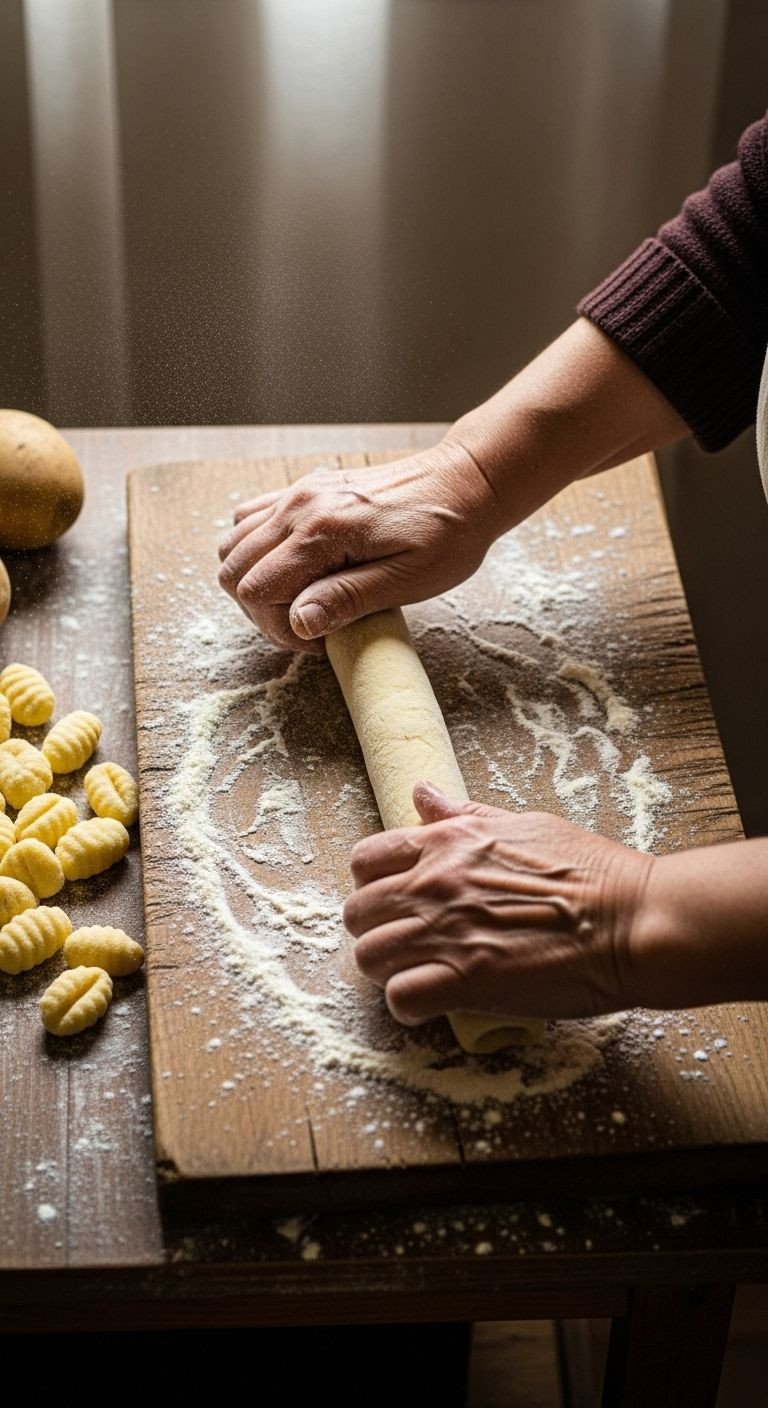
Making homemade potato gnocchi is a simple process of combining cooked, riced potatoes with flour and egg yolk to form a soft dough. These rustic, pillowy dumplings are surprisingly easy to make and serve as a perfect canvas for any sauce, from simple brown butter and sage to a rich tomato sauce.
Don’t be intimidated by the idea of making pasta from scratch! Gnocchi are the most forgiving and rustic place to start. It’s more about feel than precision.
Ingredients:
* 2 lbs Russet potatoes (about 3-4 medium)
* 1 ½ cups ’00’ or all-purpose flour, plus more for dusting
* 1 large egg yolk
* 1 tsp salt
* Semolina flour for dusting the baking sheet
Instructions:
1. Boil or bake the potatoes with their skins on until a fork easily pierces them. Baking results in a drier potato, which is ideal.
2. Let them cool just enough to handle, then peel the skins off. Pass the warm potatoes through a potato ricer or a food mill onto a clean, floured surface. This creates a light, fluffy texture.
3. Create a well in the center of the riced potato. Add the egg yolk and the salt into the well.
4. Begin to gradually incorporate the flour, using a bench scraper or your hands. Knead very gently until a soft, slightly sticky dough forms. The biggest mistake is overworking the dough, which develops gluten and makes the gnocchi tough.
5. Divide the dough into 4-5 pieces. Roll each piece into a long rope about 1/2-inch thick.
6. Use a knife or bench scraper to cut the ropes into 3/4-inch pieces. You can cook these “pillows” as they are, or for a traditional touch, roll each one over the back of a fork or a gnocchi board to create ridges that catch the sauce.
7. Cook the gnocchi in a large pot of boiling, generously salted water. They are done when they float to the top, which usually takes just 2-3 minutes.
8. Remove with a slotted spoon and toss immediately with your favorite sauce.
Nonna’s Tip: “Use older potatoes with less moisture for the lightest, fluffiest gnocchi. If your dough is too wet, you’ll add too much flour, making them dense and heavy like rocks.”
Pin this recipe to your “Handmade Pasta” board for later!
2. Pasta Alla Gricia (The Original Roman Masterpiece)
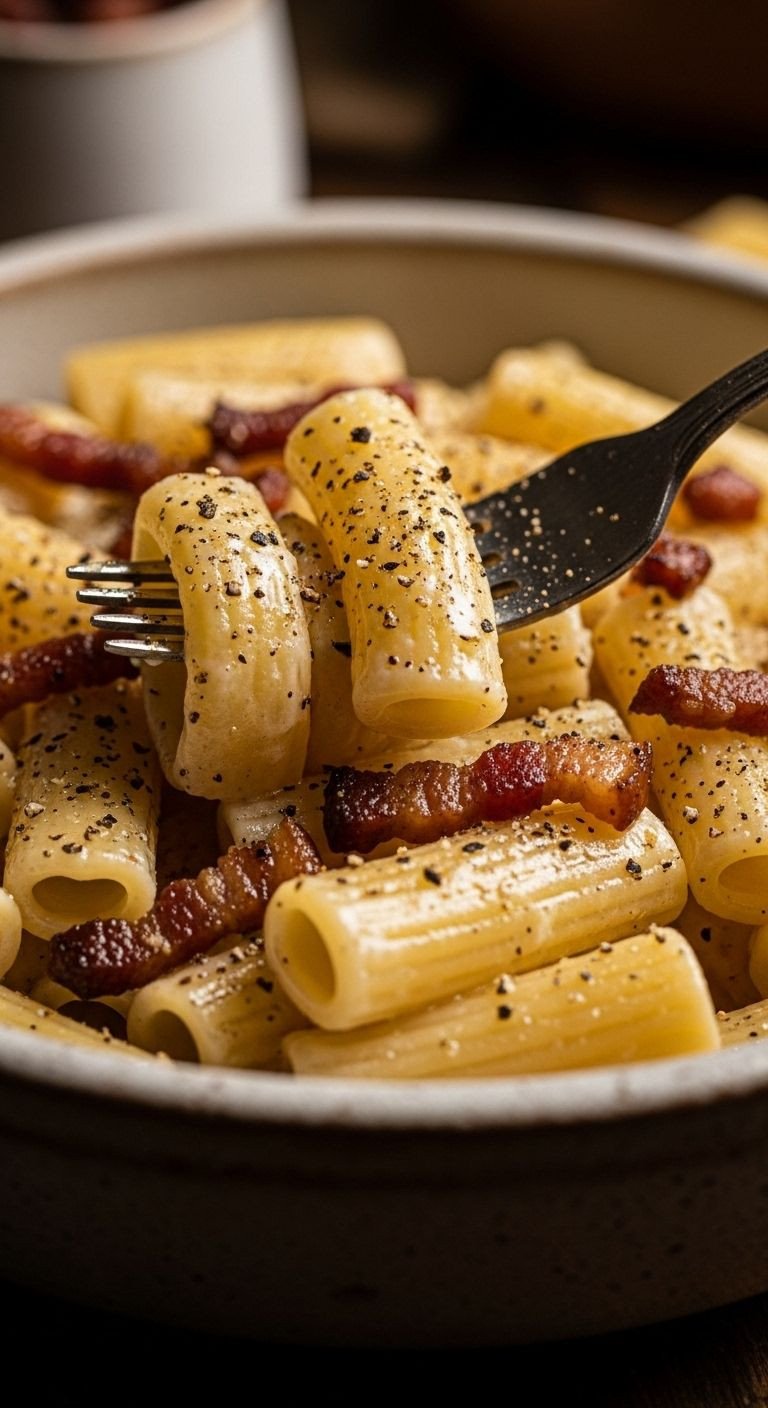
Pasta Alla Gricia is a classic Roman dish made with just four ingredients: pasta, guanciale (cured pork jowl), Pecorino Romano cheese, and black pepper. The magic lies in emulsifying the rendered pork fat with starchy pasta water and cheese to create an intensely flavorful, creamy sauce without any cream.
This is simplicity at its most profound. Before tomatoes were introduced to Italy, this was the original shepherd’s pasta. It’s the ancestor of both Carbonara (which adds egg) and Amatriciana (which adds tomato). Mastering Gricia is a true badge of honor.
Ingredients:
* 1 lb Rigatoni or Spaghetti
* 6 oz Guanciale, cut into strips or small cubes
* 1 ½ cups Pecorino Romano cheese, finely grated
* 1 tbsp coarse black pepper, freshly ground
* Salt for the pasta water
Instructions:
1. Bring a large pot of water to a boil. Once boiling, add a generous amount of salt.
2. While the water heats, add the guanciale to a large, cold skillet. Place it over medium-low heat. This slow rendering process allows the fat to melt away, leaving the meat perfectly crisp and golden.
3. Once crispy, use a slotted spoon to remove the guanciale pieces, leaving all that glorious rendered fat in the pan.
4. Cook the pasta according to package directions until perfectly al dente.
5. Just before the pasta is done, add the coarse black pepper to the hot fat in the skillet. Let it toast for about 30 seconds until fragrant. This blooms the flavor of the pepper.
6. Drain the pasta, making sure to reserve at least a cup of the starchy, cloudy pasta water. This is liquid gold!
7. Add the drained pasta directly to the skillet with the fat and pepper. Remove the pan from the heat. Add the grated Pecorino and a small splash of the reserved pasta water. Stir and toss vigorously to melt the cheese and create a creamy, emulsified sauce. If it’s too thick, add another splash of pasta water until it’s glossy and coats the pasta perfectly.
8. Toss in the crispy guanciale pieces and serve immediately with another generous grating of Pecorino and a final crack of black pepper.
Lesson Learned: “This dish is the ancestor of Amatriciana. The creaminess comes from the emulsification of the rendered pork fat, starchy pasta water, and cheese—not from adding cream. If your sauce breaks or gets clumpy, it’s usually because the pan was too hot when you added the cheese.”
Save this 4-ingredient wonder to your “Quick Dinners” board!
3. Spaghetti All’Assassina (Spicy “Killer” Spaghetti)
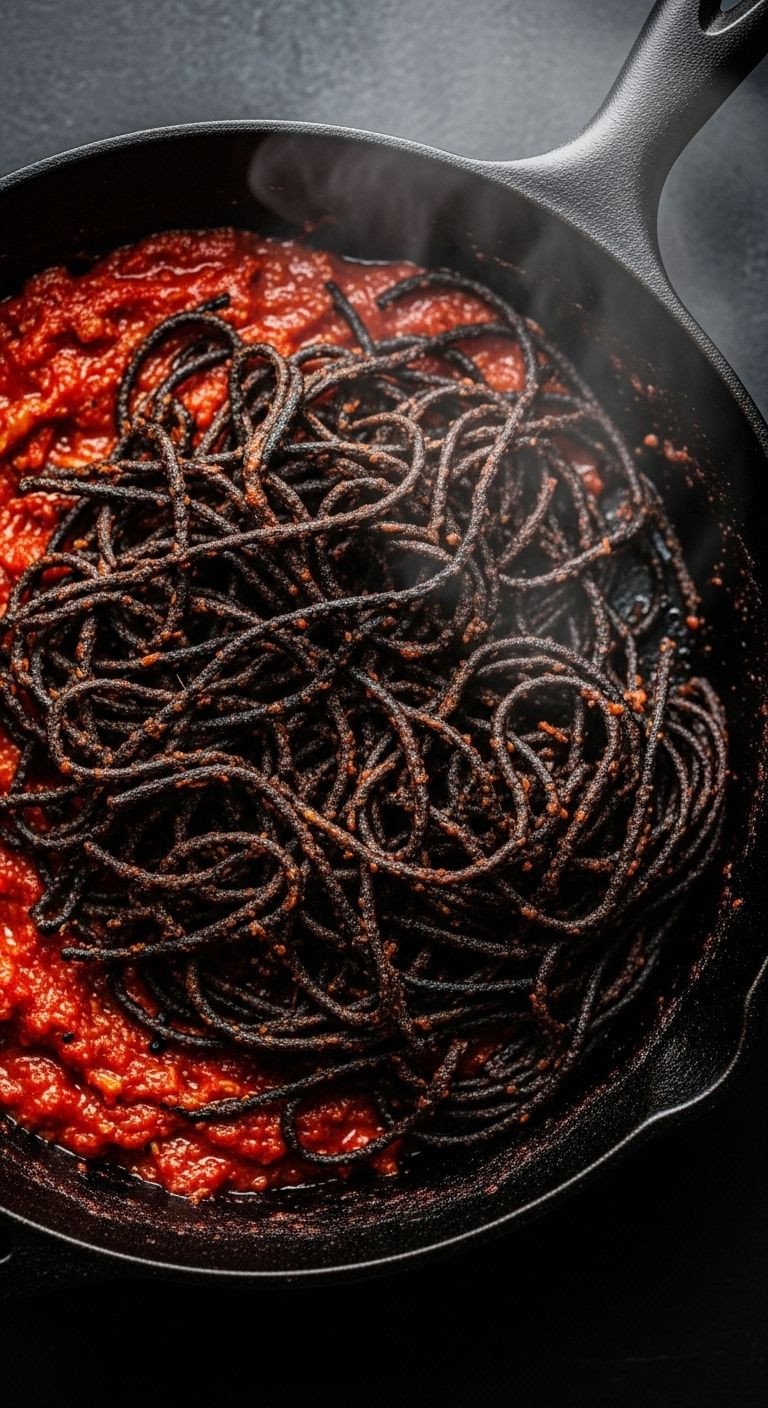
Spaghetti all’Assassina is a unique one-pan pasta where dry spaghetti is fried and charred in a spicy tomato broth, absorbing the liquid like a risotto. This “killer spaghetti” from Puglia develops an intensely savory, spicy, and smoky flavor from the caramelized and crispy pasta strands.
This is a more modern classic, but it’s built on old-world principles of creating immense flavor from simple ingredients. It breaks all the rules of boiling pasta, and the result is absolutely addictive.
Ingredients:
* 1/2 lb Dry spaghetti
* 1 cup Tomato Passata (smooth tomato purée)
* 3 cups Water or light chicken broth
* 2 cloves Garlic, smashed
* 1 Dried red chili, or 1 tsp Calabrian chili paste
* 3 tbsp Extra-virgin olive oil
* Salt to taste
Instructions:
1. In a large measuring cup or bowl, combine the tomato passata and the water/broth. Stir and season with salt. This is your cooking liquid.
2. Heat the olive oil in a large, heavy-bottomed skillet or cast-iron pan over medium heat. Add the smashed garlic cloves and chili, and cook until fragrant, about 1-2 minutes.
3. Pour about one cup of the tomato broth into the skillet and bring it to a vigorous simmer.
4. Add the dry spaghetti to the pan in a single layer. Don’t worry if it doesn’t all fit perfectly at first. As it softens, you can push it down.
5. Cook the spaghetti, letting it absorb the liquid. Here’s the key: once the liquid evaporates, let the pasta fry and char against the bottom of the pan. You want to hear it sizzle and pop. This is where the flavor comes from.
6. Once you have some nice charred spots, add another ladle of the tomato broth. Scrape the bottom of the pan to release the crispy bits and toss the pasta. Repeat this process—letting the liquid absorb, charring the pasta, then adding more liquid—until the spaghetti is al dente. It’s a method very similar to making risotto.
7. The final dish should be intensely flavored and saucy, but not swimming in liquid, with a fantastic textural contrast between the tender and crispy strands.
Pro-Tip: “Don’t be afraid of the char! The ‘bruciacchiato’ (burnt) bits are the signature of this dish and where all the smoky, complex flavor comes from. Use a sturdy cast-iron or carbon steel pan that can handle the heat and scraping.”
Dare to try it? Pin this “Killer Spaghetti” recipe now!
4. Skillet Chicken Cacciatore (“Hunter’s Style” Chicken)
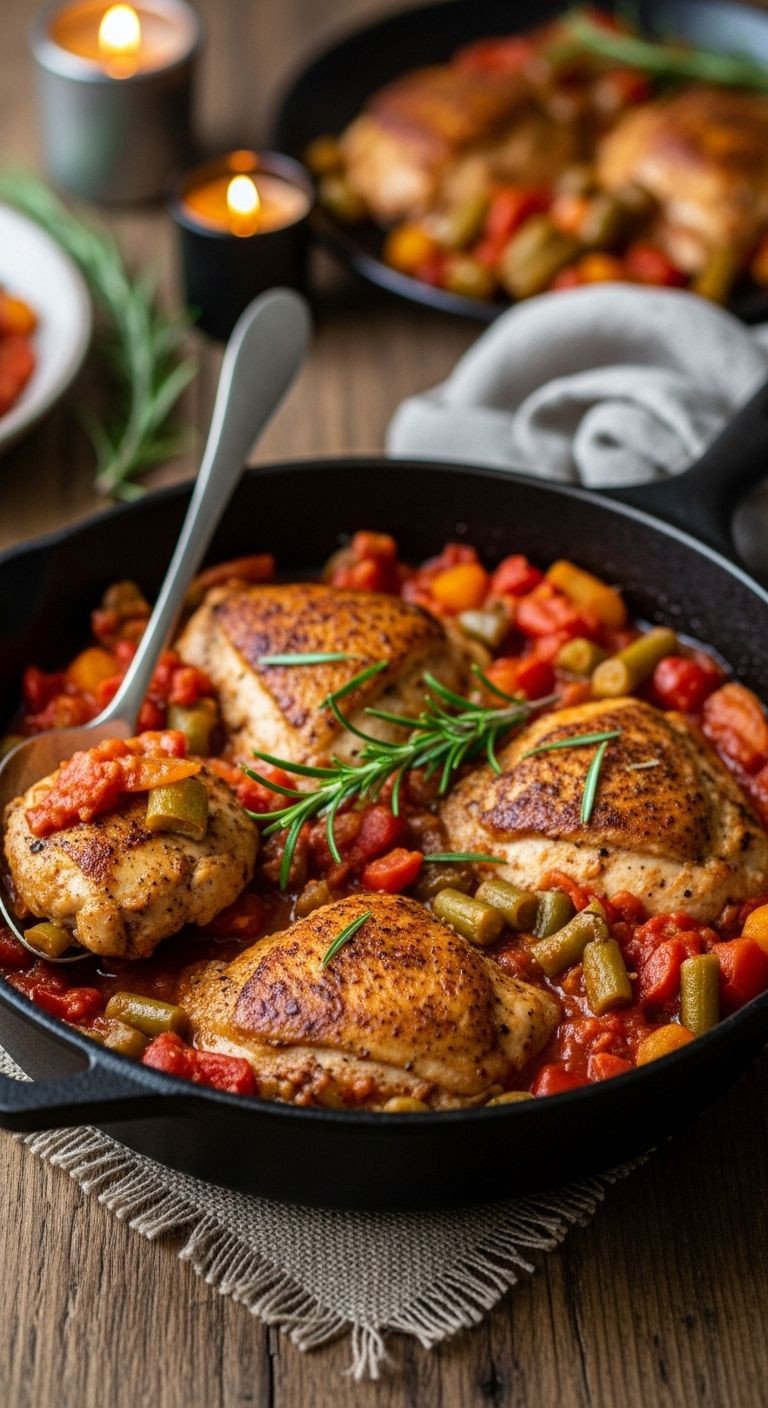
Chicken Cacciatore is a rustic “hunter-style” stew where chicken pieces are first browned and then braised in a flavorful sauce of tomatoes, onions, bell peppers, and herbs. It’s a hearty, comforting, and incredibly fragrant one-pan meal that embodies the soul of Italian country cooking.
There are countless versions of Cacciatore across Italy. Some include mushrooms, others olives, some use white wine instead of red. This version is a classic, accessible preparation that always hits the spot.
Ingredients:
* 8 Bone-in, skin-on chicken thighs
* 2 tbsp Olive oil
* 1 Large onion, chopped
* 1 Red bell pepper, sliced
* 1 Yellow bell pepper, sliced
* 3 Cloves garlic, minced
* 1/2 cup Dry red wine (like Chianti), optional
* 1 (28 oz) can Crushed tomatoes
* 1 tsp Dried oregano
* 1 Sprig fresh rosemary
* Salt and fresh black pepper to taste
Instructions:
1. Pat the chicken thighs completely dry with paper towels (this is key for crispy skin) and season them generously on all sides with salt and pepper.
2. Heat the olive oil in a large, heavy skillet or Dutch oven over medium-high heat. Place the chicken skin-side down and sear, without moving it, for 6-8 minutes, until the skin is deep golden brown and crispy. Flip and sear for another 3-4 minutes. Remove the chicken to a plate and set aside.
3. Pour off all but 2 tablespoons of the rendered fat from the skillet. Add the chopped onion and bell peppers, season with a pinch of salt, and cook until softened and lightly browned, about 8-10 minutes.
4. Add the minced garlic and cook for one minute more until fragrant.
5. If using, pour in the red wine to deglaze the pan. Use a wooden spoon to scrape up all the browned bits (the fond) from the bottom of the pan. Let the wine simmer until it has reduced by about half.
6. Stir in the crushed tomatoes, dried oregano, and the sprig of rosemary. Bring the sauce to a simmer.
7. Return the seared chicken to the skillet, placing it skin-side up so it stays crispy. Reduce the heat to low, cover the skillet, and let it simmer gently for 25-30 minutes, or until the chicken is cooked through and tender.
8. Serve hot, spooning the rich sauce and vegetables over the chicken.
Nonna’s Tip: “Always sear the chicken properly first. This not only gives you crispy skin but also builds a foundation of flavor (the ‘fond’) in the bottom of the pan, which is essential for a rich sauce. Don’t rush this step!”
Pin this perfect one-pan dinner for your next cozy night in!
5. Polpette (Classic Italian Meatballs) in Sunday Sauce
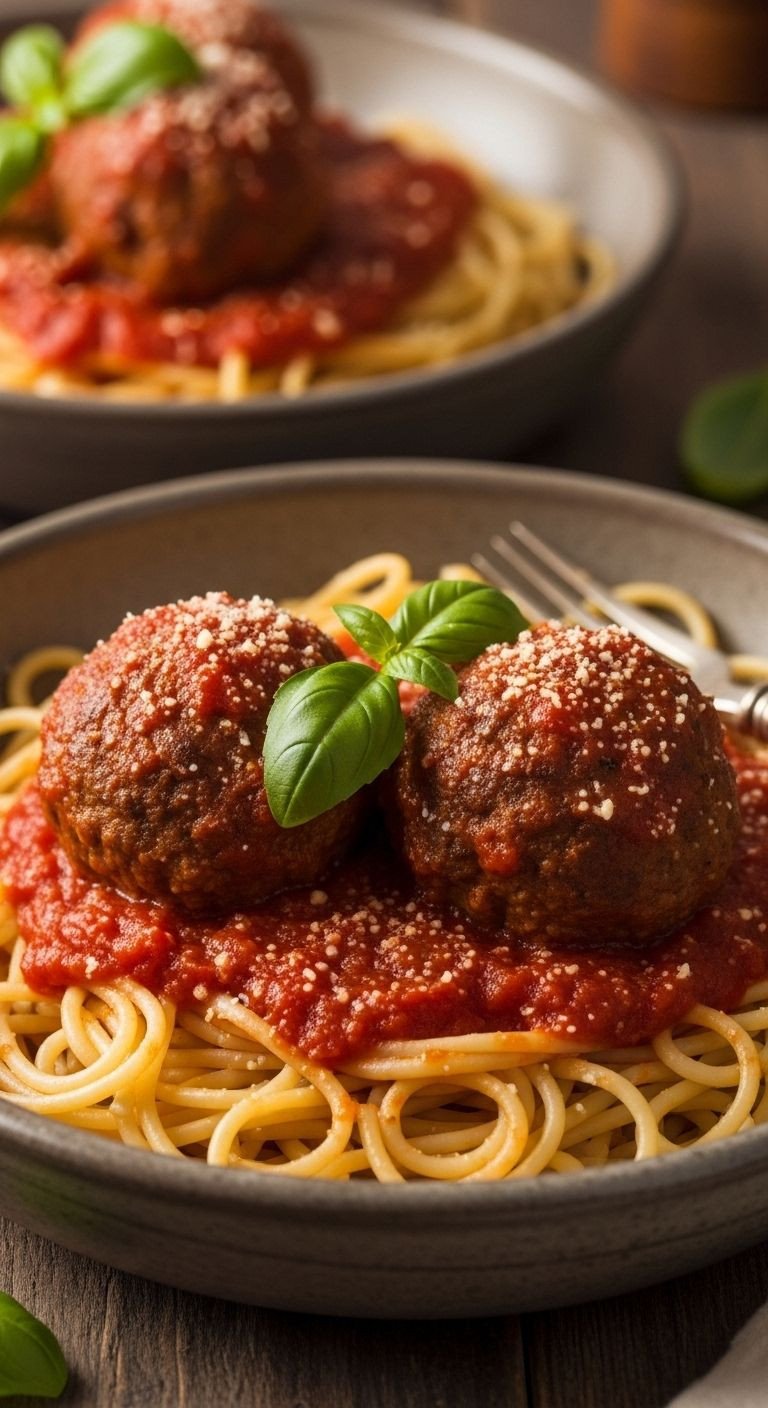
Authentic Italian meatballs, or polpette, are tender spheres of ground meat, breadcrumbs, and cheese that are browned and then slow-simmered in a rich tomato “Sunday Sauce”. The result is incredibly moist meatballs and a sauce that has been deeply flavored by the meat.
This isn’t a quick weeknight meal. This is a weekend project, a labor of love. A pot of Sunday Sauce simmering on the stove is the smell of a true Italian-American home. The meatballs should be light and tender, never dense and rubbery.
Ingredients for the Meatballs:
* 1 lb Ground beef (80/20)
* 1 lb Ground pork
* 1 cup Fresh breadcrumbs (from stale bread, crusts removed)
* 1/2 cup Milk
* 1 cup Grated Parmesan or Pecorino Romano cheese
* 1/2 cup Chopped fresh parsley
* 2 Cloves garlic, minced
* 2 Large eggs, lightly beaten
* 1 ½ tsp Salt
* ½ tsp Black pepper
Ingredients for the Sauce:
* 2 tbsp Olive oil
* 1 Large onion, finely chopped
* 3 Cloves garlic, thinly sliced
* 2 (28 oz) cans San Marzano crushed tomatoes
* 1 large sprig of fresh basil
* Salt to taste
Instructions:
1. For the meatballs: In a small bowl, soak the fresh breadcrumbs in the milk for 5-10 minutes. This is called a panade and it’s the secret to moist meatballs.
2. In a large bowl, add the ground beef, ground pork, soaked breadcrumbs (squeeze out excess milk), grated cheese, parsley, minced garlic, beaten eggs, salt, and pepper. Use your hands to gently mix all the ingredients until they are just combined. Do not overmix, or your meatballs will be tough.
3. Form the mixture into balls about 2 inches in diameter.
4. For the sauce & cooking: Heat the olive oil in a large, heavy pot or Dutch oven over medium heat. Brown the meatballs in batches, turning them so they get colored on all sides. They don’t need to be cooked through. Remove the browned meatballs to a plate.
5. In the same pot, add the chopped onion and cook until soft and translucent. Add the sliced garlic and cook for another minute.
6. Pour in the crushed tomatoes, add the basil sprig, and season with salt. Stir everything together, scraping up any browned bits from the meatballs.
7. Bring the sauce to a simmer, then gently return the meatballs to the pot.
8. Reduce the heat to the lowest possible setting, partially cover the pot, and let it all simmer for at least 2 hours, stirring occasionally. The longer it simmers, the better. The sauce will become rich and thick, and the meatballs will be melt-in-your-mouth tender. Serve over pasta.
Lesson Learned: “The secret to a great Sunday Sauce is time. The long, slow simmer allows the flavors of the meat to meld with the tomatoes, creating a sauce that’s richer and more complex than any quick version could ever be. It’s an investment that pays off in flavor.”
Bring the family together! Pin this Sunday Sauce recipe.
6. The Only Tiramisu Recipe You’ll Ever Need

A classic Tiramisu is a no-bake dessert made by layering coffee-soaked ladyfinger biscuits (savoiardi) with a rich and airy cream made from mascarpone cheese, egg yolks, and sugar. The entire dessert is chilled to set and finished with a generous dusting of unsweetened cocoa powder.
This is the quintessential Italian dessert for a reason. It’s elegant, surprisingly light, and perfectly balances the bitterness of coffee and cocoa with the sweet, rich cream. An authentic Tiramisu does not contain heavy cream; the lightness comes from properly beaten eggs and quality mascarpone.
Ingredients:
* 6 Large egg yolks
* ¾ cup Granulated sugar
* 1 lb (16 oz) Mascarpone cheese, at room temperature
* 1 ½ cups Strong brewed espresso or very strong coffee, cooled completely
* 2 packs (about 48) Savoiardi (Italian ladyfinger biscuits)
* Unsweetened cocoa powder for dusting
Instructions:
1. In a large bowl, using an electric mixer, whisk the egg yolks and sugar on high speed for about 5 minutes, until the mixture is pale yellow, thick, and has doubled in volume.
2. Add the room-temperature mascarpone cheese to the egg yolk mixture. Gently fold it in with a spatula until it is smooth and fully incorporated. Be careful not to overmix, as mascarpone can curdle.
3. Pour the cooled espresso into a shallow dish.
4. Working one at a time, quickly dip each side of a ladyfinger into the espresso. The goal is to moisten it, not make it soggy and fall apart—a quick 1-2 second dip per side is perfect.
5. Arrange a single layer of the dipped ladyfingers in the bottom of an 8×8 inch or similar-sized serving dish.
6. Spread half of the mascarpone cream mixture evenly over the ladyfingers.
7. Repeat with another layer of coffee-dipped ladyfingers and top with the remaining mascarpone cream, smoothing the top.
8. Cover the dish with plastic wrap and refrigerate for at least 4 hours, but preferably overnight. This chilling time is crucial for the dessert to set and for the flavors to meld together.
9. Just before serving, use a fine-mesh sieve to dust the top generously with unsweetened cocoa powder.
Pro-Tip: “The name Tiramisù means ‘pick me up.’ Use high-quality, strong espresso for the best flavor—it’s a main ingredient, not an afterthought. Letting it rest overnight is non-negotiable; it allows the ladyfingers to soften perfectly and the dessert to set properly for clean, beautiful slices.”
Pin this showstopper dessert for your next dinner party!
Key Takeaways: Your Quick Guide to Cooking Like a Nonna
Feeling inspired? Here’s a quick summary of the core principles to remember as you start your journey into authentic Italian cooking.
- Focus on Quality: The secret isn’t complexity, it’s using the best possible ingredients you can find—good olive oil, real Italian cheeses, fresh, seasonal produce.
- Simplicity is Key: Most truly authentic dishes have very few ingredients. Your job is to let them shine, not to mask them.
- Master the Classics: Start with foundational recipes like Homemade Gnocchi, Pasta Alla Gricia, or a simple Sunday Sauce. They will teach you more about Italian flavor profiles than any complex dish.
- Patience Pays Off: Whether it’s slow-rendering guanciale, slow-simmering a sauce for hours, or letting Tiramisu set overnight, don’t rush the process. Time is often the most important ingredient.
FAQs About authentic italian recipes
H3: What is the most authentic Italian dish?
There isn’t one single “most authentic” dish, as Italian cuisine is hyper-regional and authenticity is tied to local tradition. However, dishes with deep historical roots and simple ingredients are considered highly authentic. Examples include Pasta Alla Gricia from Rome, Tagliatelle al Ragù from Bologna, and the original Pizza Margherita from Naples.
H3: What is real authentic Italian food?
Real authentic Italian food is defined by its simplicity and its focus on high-quality, seasonal ingredients. It prioritizes the natural flavor of its components over heavy sauces or complicated preparations. It’s food that is rooted in a specific region’s history and agricultural landscape, often passed down through families, just like the recipes from a Nonna’s kitchen.
H3: What are the top 10 Italian dishes for dinner?
While tastes vary, ten classic Italian dinner dishes include Tagliatelle al Ragù (Bolognese), Lasagna, Risotto alla Milanese, Pizza Margherita, Chicken Cacciatore, Osso Buco, Spaghetti alla Carbonara, Fiorentina Steak, Polpette (Meatballs) in sauce, and various regional fresh pasta dishes like Gnocchi or Ravioli.
Final Thoughts
Bringing the soul of a Nonna’s kitchen into your home isn’t about perfectly replicating every single step. It’s about adopting a philosophy. It’s about celebrating family, heritage, and the simple, profound joy that comes from sharing a good meal made with love. It’s about understanding that sometimes, the most delicious things in life are also the most simple.
The techniques and flavors you’ve learned today are more than just recipes; they are a foundation. Now you have the tools to cook with confidence, to trust your ingredients, and to create your own traditions.
Which of these Nonna-approved recipes will you be trying first? Let us know in the comments below
